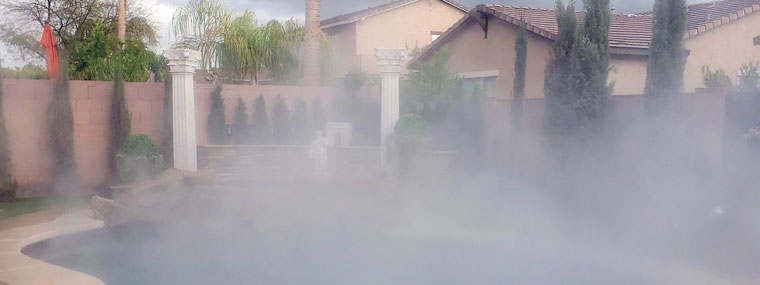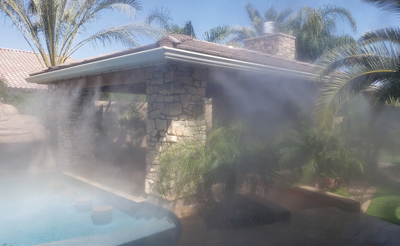
Misters
Ideal for Disinfecting and Sanitizing
By Diane M. Calabrese / Published April 2022

Let’s just put it this way: Sanitation and disinfection got renewed attention in the last two years. In turn, interest in tools for applying chemicals—uniformly and in the minimum effective amount—got the attention of more and more contractors. Contractors were asked not only to clean but also to disinfect. That’s no surprise.
“Misters are ideal for disinfecting and sanitizing any surface quickly and efficiently, especially in high-contact areas,” says Karl Loeffelholz, distributor division manager at Mi-T-M Corporation in Peosta, IA. His company is one of many that manufactures misters, aiming to match them to their setting as precisely as possible.
Technically mist is comprised of water particles ranging from 50 to 100 microns in diameter. (Fog droplets are less than 50 microns in diameter.)
Because some misters see long periods of uninterrupted service, such as those in a solarium, they cannot be obtrusive to the senses, especially hearing. (Nothing disrupts the experience of immersion in an indoor garden more than a constant drone.)
(For the basics of pumps used in misters, see “Misting Pumps” — https://www.cleanertimes.com/magazine/cleaner-times-articles-2/misting-pumps.)
Misters for applying disinfectants are not new to the industry. “We have sold these units to a wide variety of customers,” says Dennis Black, president of McHenry Pressure Cleaning Systems Inc. in Frederick, MD.
“Some of the uses our customers [have made of misters] are disinfecting of dump trucks and heavy equipment, postal vehicles, building and business fronts, and school buses,” says Black. And mobile cleaners have been among the purchasers.
Anyone using misting equipment for disinfection must be well versed in chemical use. That encompasses deploying chemicals correctly and making the optimal match for a setting. Moreover, the Environmental Protection Agency (EPA) offers rules and guidance in addition to those from OSHA.
Beyond meeting all regulations, anyone using misters must take care to ensure they themselves do not become the source of a problem instead of the solution to it. Stagnation of water and biofilms can encourage the growth of bacteria like Legionella.
Yet any caution tied to the use of misters to improve well-being—by promoting evaporative cooling to create a more welcoming thermal environment, for one—is more than outweighed by all the good misters do.
Successful use of misters requires the same due diligence as the use of any tool in or related to our industry. And their use—both portable models and stationary systems—continues to expand.
Yes, portable mist units are important. But their use is “miniscule compared to the actual placement of outdoor cooling at residential restaurant patios and industrial requirements,” says Bill Sommers, president of Pressure Systems Industries Inc. – Mist Air in Phoenix, AZ.
Sommers has a 34-year association with misters. “I built the first high-pressure misting units to mist/humidify the cotton warehousing in Arizona and California,” he explains. The success of his design became a playbook for others to follow.
Today, misting technology is used across a wide range of settings, explains Sommers. The range includes application of sanitizing chemicals; balanced humidification in enclosures such as greenhouses; dust suppression in quarrying, horse barns, and dog kennels; and fly and mosquito control.
Despite the ever-expanding use of misters, some aspects of the technology deserve amplification, explains Sommers. And he gives us a primer on water hardness and noise, specifically.
“Hard water plugs nozzles,” says Sommers. The blockage happens because dissolved solids, such as calcium compounds, come out of solution when a nozzle dries after shutdown. A water softener is recommended for geographic areas where hard water prevails. And filter screens are always a must on the inlet pump.
“Noise is a reality with misters,” explains Sommers. Thus, the location of the equipment must be considered before installation. “All rotating mechanical devices will emit decibels,” he says.
Yet by slowing down the pump to operate at 50 percent of recommended rpm (and approximately 50 percent of operating pressure), it is possible to achieve quieter output, explains Sommers. This is a technique his company uses. As a side benefit, pumps have greater longevity. Noise can now be kept lower than 75 decibels.
Recalling the early development of misting tools, Sommers notes there were multiple challenges to meet. One was the development of a nozzle orifice that could be replicated in a cost-effective way. For instance, Sommers knew a gentleman, whom he recalls as Mr. Marsh, who brought economy of production to nozzle orifices used on equipment in chicken houses.
Eventually, “high pressure systems utilizing triplex positive displacement pumps became the benchmark operating at 1000 psi,” says Sommers. “They produced the necessary pressure for flash evaporation with the terminology used now as misting.”
The importance of misting in the industries and commercial enterprises the technology serves cannot be overstated. For environments where temperature and humidity control are essential, the ambient temperature and humidity can cause havoc.
What misting technology gives a venue is control over its environment. For Sommers, the literal beginning of his company’s contribution to that control was 1991, and he gives us a short account about how it happened.
“When called to demo and sell a pressure cleaner to a cotton warehouse facility, the superintendent asked if I would like to see their operation,” says Sommers. “The buildings were nominally 120×80 with forklift traffic lanes. Inside, the humidity for the cotton bales was being supplied by 20 horsepower air compressors.”
Sommers saw the opportunity to demonstrate a better option to the facility’s owner. He deployed a 20-ft. stainless steel tube with welding nozzle adapters at two-ft. intervals and a system capable of 2000 psi. That successful demonstration began his deep involvement with misting technology, allowing him to meet the requirements of clients in Arizona and other states.
“The mist/fog industry has evolved a long way from the initial attempts,” says Sommers. The worldwide scope of the technology shows every indication of growth—first, because of the utility of the technology; and second, because the technology fits snuggly with the push for doing more with less (e.g., water, energy) in order to maintain a sustainable environment.







